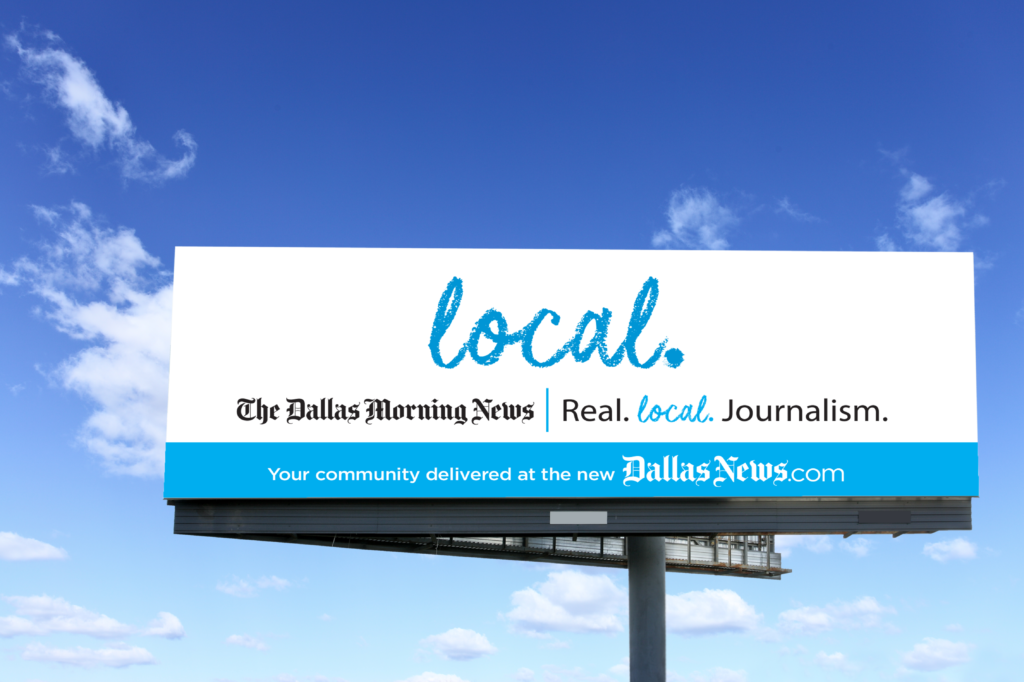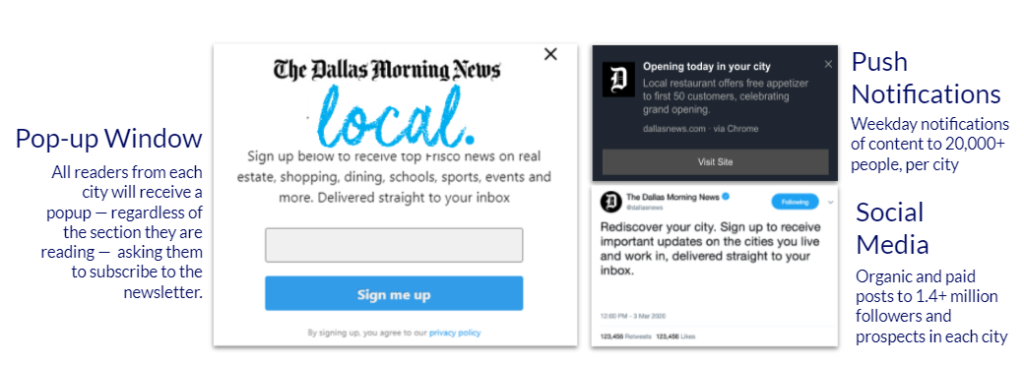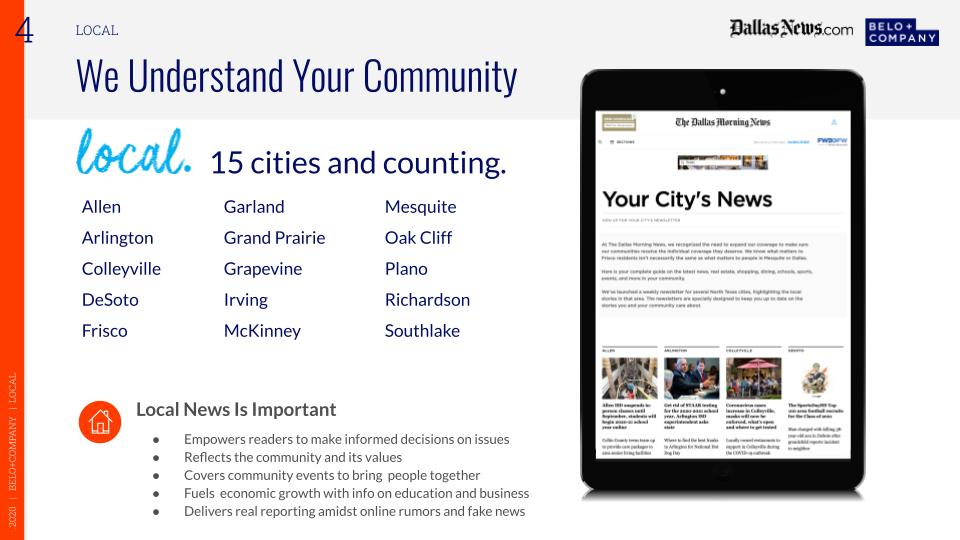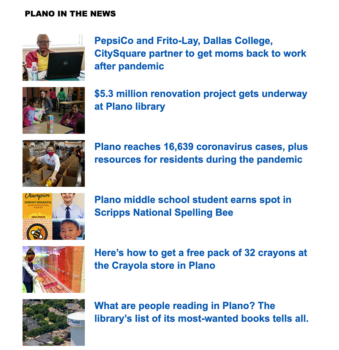How The Dallas Morning News expanded its hyperlocal journalism through a web hub and newsletter initiative
Nicole Stockdale, The Dallas Morning News,This is a series on Better News to a) showcase innovative/experimental ideas that emerge from the Knight-Lenfest Newsroom Initiative and b) share replicable tactics that benefit the news industry as a whole. This “win” comes from Nicole Stockdale, director of digital strategy at The Dallas Morning News. The News participated in the 2015-16 Major Market Table Stakes program.
Question: What communities do you serve and what can you tell us about the history of your organization?
Answer: Founded in 1885, The Dallas Morning News is Texas’ leading news organization and is the winner of nine Pulitzer Prizes. It has one of the largest newsrooms in the Southwest. In 2015, The News was in the first group of news organizations to go through the Table Stakes program. Since then, the DMN has been a leader in digital innovation among local news organizations.
The News’ mission is “making our communities stronger and more prosperous through quality journalism and innovative marketing solutions.” Our primary coverage focus is North Texas, but The News has a reach across Texas. Many state policymakers pay special attention to The News’ investigative and in-depth enterprise reporting.
Q: What problem were you trying to solve, and why was solving the problem strategically important for your organization?
A: Years of cutbacks in our suburban coverage meant that the vast majority of our daily news report was focused on either Dallas-specific coverage or big-picture regional issues, despite the fact that the majority of our subscribers live outside the city limits. Without the kind of consistent utility journalism that can attract loyal readers to our website, we also feared that much of our suburban audience wasn’t aware of the journalism we were publishing about their communities.
We needed a way to expand our hyperlocal journalism and package it with the in-depth coverage our newsroom was already publishing about those communities, thereby deepening their relationship with The Dallas Morning News and making them more likely to start — or retain — a subscription. And we needed to find a way for the effort to, at the very least, pay for itself.
The answer was DMN Local — an initiative to expand news coverage of 10 communities with a team of freelancers, creating digital hubs and newsletters to organize and promote coverage.
Q: How is this approach related to Table Stakes (e.g. one of the 7 Table Stakes and/or an outgrowth of the Knight-Lenfest initiative, etc.)?
A: This approach is related to several Table Stakes, including No. 1 (Serve targeted audiences with targeted content), No. 4 (Funnel occasional users to habitual and paying/valuable loyalists), and No. 7 (Drive audience growth and profitability from a “mini-publisher” perspective).
Q: How did you go about solving the problem?
A: Mark Francescutti (formerly director of engagement and operations on The News’ marketing team, now director of new product development at Lee Enterprises) and I combined our marketing and newsroom goals and experience to develop a plan that would both expand our community coverage and our top-of-funnel readership:
We hired freelance journalists in 10 communities to publish a handful of quick-hit hyperlocal articles — through original reporting or aggregation — that would supplement what the full-time newsroom staff could cover. Topics included restaurant openings and closings, city and school district news, crime, elections, things to do, real estate, retail and city rankings.
We also needed to make it easier for readers to find their community news. We handled that in two ways: by creating a newsletter and a web hub for each community. We tag the related hyperlocal content and the in-depth journalism the newsroom was already publishing and use those tags to feed the community newsletters and websites automatically. The websites also display events specific to that community, filtered from our main events-listing page, as well as links to community-specific content hosted elsewhere in the site, like real estate and high school sports. We also used social media and desktop push notifications to help geo-target audiences.
The project needed a full-time editor to manage the freelancers, coordinate the content and sending of the newsletters, and cultivate relationships internally (with colleagues in the newsroom, and in product, subscriptions, advertising and marketing) and externally (public officials, universities and community leaders) to pull off the project.
Mark and I also took a mini-publisher approach to ensure that this expansion of journalism would also be profitable. We estimated the page views and subscriptions the effort would generate. We worked with colleagues in advertising to estimate revenue from sponsorships, direct-sold ads and programmatic on the website and in newsletters. We got updated figures on the value of a digital subscription and churn rates to estimate the digital subscription revenue.
And we weighed all of that against the expected operating expenses — over three years’ time — to show that we expected the effort to be profitable by the second year. After the project launched in January 2020, we convened the same cross-functional group every quarter to review performance against goals and discuss any necessary changes.

This rendering shows the design of a billboard advertising DMN Local. The Dallas Morning News strategically selected communities for billboard advertising to amplify their existing digital and social marketing efforts.
Q: What worked?
A:
The goals: In January 2020, Jamie Hancock, assistant politics editor at the time, was hired to spearhead the project, starting from scratch. She had clearly defined goals to shoot for — launching coverage, newsletters and web hubs for 10 communities; reaching targets for list size, open rate and click-through rate for each newsletter; and hitting targets for page views on the web hubs and digital subscriptions directly sold off the journalism. Those goals helped Jamie focus her efforts, and she exceeded all but one of them by the end of the first year (one by 600 percent!), despite the added difficulty of the pandemic. In fact, a Facebook grant, made possible by our participation in the Accelerator program, in the middle of the year allowed us to add five additional communities, for a total of 15; a grant from Google later in the year allowed us to expand our coverage of economic development and transportation in our communities. (The original 10 communities were Allen, Arlington, DeSoto, Frisco, Irving, McKinney, Mesquite, Oak Cliff, Plano and Richardson. We later added Colleyville, Garland, Grand Prairie, Grapevine and Southlake.)
The journalism: By the end of the first year, DMN Local had published more than 2,250 articles — real news and information that brought hyperlocal coverage to communities that they otherwise wouldn’t have had. That included city-specific weekly updates on COVID-19 guidelines and deaths, inspirational articles about student achievements that got national attention and on-the-pulse stories about local social-media firestorms. This initiative helped us increase coverage and readership even as the newsroom’s budget was shrinking.
The trust-building: We were intentional about the communities we chose. Rather than target only the wealthiest communities with the highest potential subscription acquisitions, then-editor Mike Wilson and I planned for diversity — in household income, geography, race and ethnicity. We included communities that have historically been underserved, where we had more work to do to establish trust. Jamie met with community members and leaders and developed a formal partnership with one — Cheryl Smith, publisher and editor-in-chief of Texas Metro News. Both women saw ways they could work together to better cover their communities — brainstorming story ideas, collaborating on training and sharing some journalism. Their partnership helped inspire the News Media Alliance to create a guide for creating successful news publishing partnerships. (Editor’s note: Better News is an initiative of the American Press Institute, which is affiliated with the News Media Alliance.)

The Dallas Morning News used newsletter sign-up pop-ups on the site, desktop push notifications and social sharing to help more people discover their DMN Local articles.
The newsletters: We started by seeding the lists with existing readers in our target ZIP codes, letting them know we had a new newsletter tailored to their community. We added pop-up ads to the website on community-specific content, giving readers an easy opportunity to subscribe to the newsletter. Newsletter sign-ups were added to the bottom of articles. Marketing was also successful in using Keywee campaigns on Facebook to get sign-ups. And in-browser push notifications gave us one more way to target by ZIP code.

This is one of the slides in a deck that Dallas’ ad sales staff uses when it’s making pitches to local advertisers. Sponsorships and ad packages from local advertisers have brought in more revenue than expected, despite the pandemic.
The revenue: We finished the launch year ahead of plan, despite the pandemic, thanks to a resourceful ad sales department and page views that were much higher than projected. As of the first quarter of 2021, the project was self-sustaining — less than a year after coverage of the 15th community was launched.
The revenue from advertising has been a little higher than we expected, the number of subscriptions a little lower. We’re averaging about 50 new digital-subscription starts a month; we’d like to get that up to 60.
Q: What didn’t work?
A: We vastly underestimated the amount of time it would take to manage the initiative — to edit the copy, organize the newsletters, coordinate coverage with the rest of the newsroom, coach the freelancers, collaborate with other departments, etc. We quickly realized Jamie would need help editing and eventually hired two freelance editors to ease the workload.
Similarly, we’d like to do many other things but aren’t sure the ROI is there — for example, extensive social media sharing and push notifications. The newsroom’s audience team had the capacity to take on some top-line sharing but not separate accounts or segments for each community. We’ve dabbled in both areas, with help from interns and colleagues in marketing, but haven’t developed lasting solutions yet.
Q: What happened that you didn’t expect?
A: A global pandemic that upended life as we know it, personally and professionally? Honestly, despite the potential disruption to the advertising model this initiative was partly based on, we were all so grateful we had this project in the works when the pandemic hit. We had the infrastructure in place or in the works to distribute critical information quickly to readers at a time when they needed it most.

Here’s a look at some of the stories featured in the March 31, 2021, edition of the Plano newsletter.
Q: What would you do differently now? What did you learn?
A: We initially focused the project around the newsletter distribution of stories. It seemed like the most efficient and effective way to reach our audiences. That was true, but we quickly realized we needed a smart website presence, as well. That took more resources to pull off — involving web design and precious developer time — but it was worth it to have the journalism better integrated into the website and meet readers’ expectations. (We were lucky to have a dev team that quickly made room for this work in their sprints.)
At first, we started with the premise that each city would have one designated writer. But we quickly found that most of the freelancers involved in the project were interested in covering two or three cities apiece. Jamie proceeded cautiously at first to make sure no dropoff in the quality or quantity of the stories happened — but now having freelancers cover multiple cities is the norm. The writers like the extra money, and it means Jamie has more time to work with them individually.
And, as mentioned above, we launched the project without enough editing resources; the editor of the project did not have enough time to manage all the strategy, implementation, training, collaboration AND the daily editing duties. We had to add freelance editing help.
Q: What advice would you give to others who try to do this?
A: This project stems from audience-centered idea generation: What do our readers really need from us, and how can we answer that need — in a way that is valuable to them and to the company? We started with the mission and then figured out how to meet those goals while also helping the company’s bottom line. That’s taken discipline. And it’s been gratifying to see it pay off.
Q: Anything else you want to share about this initiative?
A: The DMN Local initiative has taken a lot of cross-department collaboration. It’s been critical to the success of the project — but also a benefit in its own right. Breaking down silos and developing relationships across teams is paying dividends in plenty of other projects, as well.